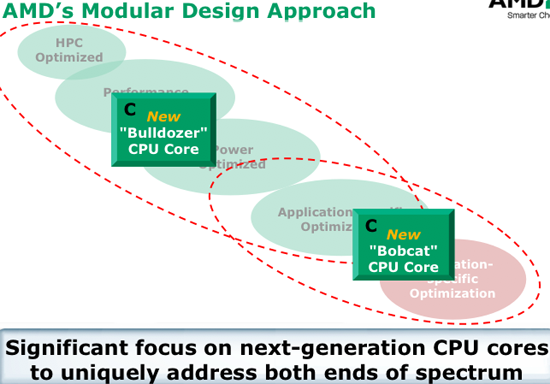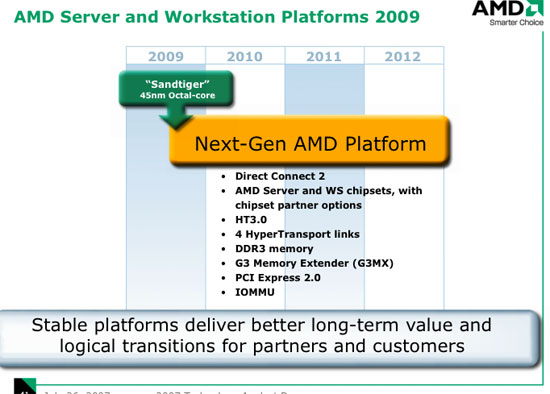Codename Mania
We're about to get into a discussion of two new CPUs cores, both due in the 2009 time frame and we'd like to apologize in advance for the sheer number of code names that may be thrown at you. In the past two days we've heard AMD tell us about the following projects:- Bulldozer
- Bobcat
- Falcon
- Sandtiger
- Shanghai
- Predator
- Budapest
- Spider
- Hardcastle
- Pinwheel
- Cartwheel
Many of these codenames refer to platforms including other codenames; understanding the architecture is honestly easier than understanding the nomenclature, which I believe is bad. We've done our best to organize it all in an easy to understand fashion, so please bear with us.
New CPUs
AMD and Intel agree on a lot these days; the 64-bit debate is over, Intel has already committed to bringing an on-die memory controller to market with Nehalem and both companies agree that to address the ultra low power market, you need a new architecture.The rule of thumb is that a single microarchitecture can cover about an order of magnitude of thermal targets, anything higher or lower and you need to look at a different architecture for maximum performance-per-watt efficiency.

AMD divides the market into two spaces: devices that have a TDP of 10 - 100W and devices that are in the 1 - 10W range. AMD has two new CPU cores that it is announcing today: Bulldozer and Bobcat, both due in 2009. Bulldozer addresses the 10 - 100W segment (much like the current K8 and Core based processors do), while Bobcat is designed for the 1 - 10W portion of the market.
Bulldozer
Due out in the first half of 2009, AMD's Bulldozer core is the true revolutionary successor to the K8 architecture. While Barcelona and Shanghai are both evolutionary improvements to the current core, Bulldozer is the first ground-up redesign since the K7.Bulldozer will require a brand new socket for two reasons: it will support a new version of AMD's Direct Connect architecture (and Hyper Transport), and it will also support DDR3. Both of these changes dramatically alter the pinout of the CPU, thus making Bulldozer the next core to not be backwards compatible with current motherboards. Once again, AMD is giving us a nice roadmap for obsolescence, which its customers have always appreciated.

Details on Bulldozer are still limited, but here's a quick list of what we know about the architecture
- Not VLIW, still OoO superscalar architecture
- Deeper pipeline than Barcelona/Shanghai
- New x86 instructions targeted at HPC and "media processing"
- increased computational density
- increased flow control capability
- extend SIMD capability targeted specifically at media data types - Hyper Transport 3 will be supported
- The chip will feature 4 HT3 links
- DDR3 support - G3MX Memory Technology
- PCIe 2.0 - IOMMU (Hardware Accelerated I/O Virtualization)
A deeper pipeline than present-day architectures means we are looking at higher clock speeds, and AMD was quick to point out that there is no dramatic change in the approach to microprocessor design with Bulldozer - it's still the same type of out of order, superscalar architecture as its predecessors and not an Itanium-like design.
Extending the x86 instruction set once more only makes sense as the usage model for general purpose microprocessors becomes more demanding. AMD wouldn't be any more specific about the types of instructions we are likely to see in Bulldozer other than they would be HPC and media processing focused.

Bulldozer's connectivity will be improved, supporting up to four HT3 links per processor (up from 3 HT links in present day CPUs). With four HT3 links you can expect to see some pretty robust multi-socket configurations built around Bulldozer cores in the server/HPC markets.
Why is PCI Express 2.0 listed as a feature of the Bulldozer core? Well, some implementations of the core (think Fusion) will actually have on-die PCI Express 2.0 controllers. These CPUs will be particularly interesting for small form factor devices, because the only additional chip you will need is a South Bridge.










31 Comments
View All Comments
Lord Evermore - Sunday, July 29, 2007 - link
What the heck are RDDR and UDDR? My only guess is the U might stand for the UMA design, but I don't know if that would be preferred for the server or workstation.Anand Lal Shimpi - Tuesday, July 31, 2007 - link
RDDR = Registered DDRUDDR = Unbuffered DDR
Take care,
Anand
Martimus - Thursday, August 2, 2007 - link
Ok, what is OoO? I couldn't find it with a search on Google.Spartan Niner - Saturday, August 4, 2007 - link
OoO is "out-of-order" referring to OoOE, "out-of-order-execution"http://en.wikipedia.org/wiki/Out_of_order_executio...">http://en.wikipedia.org/wiki/Out_of_order_executio...
Martimus - Monday, August 6, 2007 - link
Thanks.xpose - Saturday, July 28, 2007 - link
This is the best future roadmap article I have ever read. I am actually excited. No really.najames - Friday, July 27, 2007 - link
I am an AMD fanboy, of 7 computers I have at home, only the 5 year old laptop has an Intel chip now. Dual cores are actually likely all I REALLY need. That said, I am sick of a bunch of hype and no new products. It's all blow and no show. I don't care about years down the road because it could all change between now and then.AMD/ATI could be a good thing too if they make good, polished drivers, 100% working for what was promised. How about throwing people a bone to make them switch, maybe even make some kick butt Linux drivers too.
We were all on an AMD bus and nobody has been driving since the X2 chip. They taunted Intel and handed out huge bonuses, but forgot about any new development. I have to credit Intel, they kicked butt with Core 2, and seem to be doing more butt kicking going forward.
I watched Hector on CNBC last night and he didn't look like he had a clue what was going on. Granted they weren't asking him details of any processors, but he was dodging basic business questions. Why do I have several hundred shares of AMD?
Regs - Monday, July 30, 2007 - link
Because those relatively cheap shares, compared to Intel's, might be worth hundreds of times more one day from that stuff you call blow. Blow = prospects in business terms.
I would say the same thing as you did though at first. It's obvious AMD and ATi's pipeline dried up and unfortunately both consecutively. You can argue that the 2900XT is a good card, performs well, etc..etc.. but that doesn't explain why AMD offers crapware for main stream (where the real money is). As for AMD's CPU line up...well..you can only sell old for so long in the technology sector without taking a hit.
kilkennycat - Friday, July 27, 2007 - link
.... dump ATi. The marriage made in hell. New products unable to meet schedule and with inferior performance, thus no way of rapidly recovering development costs by pricing for performance.Dave Orton sure did a neat sell-job on AMD, walking away with $$millions when AMD paid a 20% premium for a chronically non-performing company barely managing to eke out some tiny profits during the last couple of years. No wonder Mr. Orton was finally shown the door.
kleinwl - Friday, July 27, 2007 - link
What is the problem with AMD, did they not receive enough feedback that UVD is a "must have" on high end units. I don't want to have choose between good gaming performance and movie performance... I am paying a ridiculous premium already for hardware... the least they could do is make sure it has all the bells and whistles.